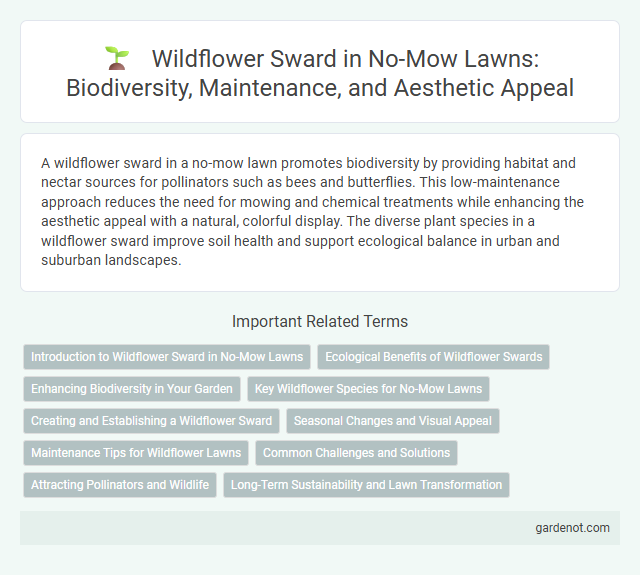A wildflower sward in a no-mow lawn promotes biodiversity by providing habitat and nectar sources for pollinators such as bees and butterflies. This low-maintenance approach reduces the need for mowing and chemical treatments while enhancing the aesthetic appeal with a natural, colorful display. The diverse plant species in a wildflower sward improve soil health and support ecological balance in urban and suburban landscapes.
Introduction to Wildflower Sward in No-Mow Lawns
Wildflower sward in no-mow lawns enhances biodiversity by supporting pollinators such as bees and butterflies, while reducing maintenance needs and water consumption. This low-maintenance green space features native wildflowers integrated into grassland, promoting natural habitat restoration and soil health improvement. Emphasizing native plant species helps create resilient ecosystems that thrive without frequent mowing or chemical treatments.
Ecological Benefits of Wildflower Swards
Wildflower swards significantly enhance biodiversity by providing habitats and food sources for pollinators such as bees, butterflies, and other beneficial insects, contributing to the overall health of local ecosystems. These swards improve soil quality through root diversity, which supports nutrient cycling and reduces erosion. Furthermore, wildflower swards require less maintenance and chemical input than traditional lawns, promoting sustainable landscaping practices and reducing environmental pollution.
Enhancing Biodiversity in Your Garden
Wildflower swards boost garden biodiversity by providing habitats and food for pollinators such as bees, butterflies, and other beneficial insects. These low-maintenance, no-mow areas support native flora, improving soil health and encouraging a balanced ecosystem. Incorporating wildflower swards in your garden promotes ecological resilience and vibrant seasonal color without frequent mowing.
Key Wildflower Species for No-Mow Lawns
Key wildflower species for no-mow lawns include native varieties such as oxeye daisy (Leucanthemum vulgare), bird's-foot trefoil (Lotus corniculatus), and harebell (Campanula rotundifolia), which promote biodiversity and drought resistance. These species thrive with minimal maintenance, supporting pollinators like bees and butterflies. Incorporating a diverse mix of grasses and wildflowers enhances soil health and creates a resilient, visually appealing no-mow lawnscape.
Creating and Establishing a Wildflower Sward
Creating and establishing a wildflower sward involves preparing the soil by removing existing grass and weeds, then sowing a carefully selected mix of native wildflower seeds suitable for the local climate and soil conditions. Regular monitoring and light maintenance, such as occasional weeding and selective mowing to prevent invasive species, ensure the sward thrives and supports biodiversity. Over time, a wildflower sward enhances pollinator habitats, boosts soil health, and adds vibrant seasonal color to no-mow lawns.
Seasonal Changes and Visual Appeal
Wildflower swards transform throughout the seasons, showcasing vibrant blooms in spring and summer that attract pollinators like bees and butterflies. In autumn, seed heads and dried flowers add texture and interest, supporting local wildlife during colder months. Their dynamic visual appeal enhances garden biodiversity while providing year-round ecological benefits.
Maintenance Tips for Wildflower Lawns
Wildflower swards require minimal mowing to preserve plant diversity and promote healthy growth, typically limiting cuts to once or twice per year, ideally late in the season after seed set. Using a high mower set to 8-10 cm helps protect low-growing species and reduces soil disturbance. Removing cuttings prevents nutrient buildup, encouraging wildflowers over grasses for a thriving, low-maintenance no-mow lawn.
Common Challenges and Solutions
Wildflower swards in no-mow lawns often face challenges such as invasive weed encroachment, uneven plant establishment, and poor soil conditions. Solutions include selecting native species adapted to local climates, implementing targeted weed control methods like manual removal or selective herbicides, and improving soil health through organic amendments. Consistent monitoring and adaptive management enhance the success and biodiversity of wildflower swards.
Attracting Pollinators and Wildlife
A no-mow wildflower sward creates a rich habitat by supporting diverse pollinators such as bees, butterflies, and hoverflies. Native wildflowers provide nectar and pollen sources critical for pollinator feeding and breeding cycles, enhancing biodiversity. This natural lawn alternative also offers shelter and food for beneficial wildlife, promoting ecological balance in urban and suburban gardens.
Long-Term Sustainability and Lawn Transformation
Wildflower swards promote long-term sustainability by enhancing biodiversity and reducing the need for chemical inputs and frequent mowing. Their deep-rooted plant species improve soil health, water retention, and carbon sequestration, transforming traditional lawns into resilient ecosystems. Over time, these natural meadows support pollinators and wildlife, creating a vibrant, low-maintenance landscape.
Wildflower sward Infographic

 gardenot.com
gardenot.com